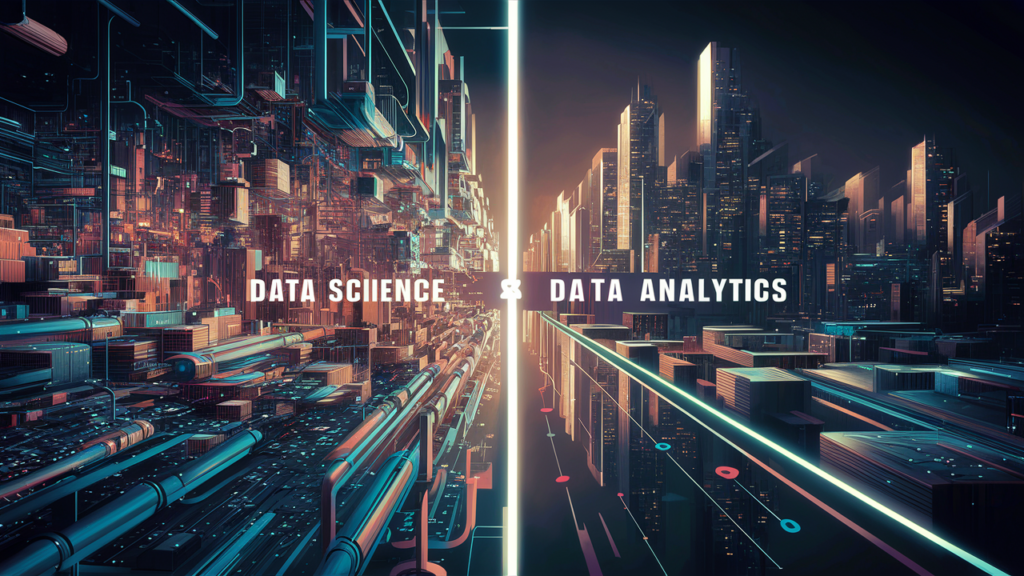In today’s data-driven world, “data science” and “data analytics” often pop up in tech conversations, job postings, and academic discussions. But what exactly sets these two fields apart? Let’s dive into an engaging journey through data science and data analytics, making the differences between these two fascinating fields as clear as polished data visualization.
Data Science vs. Data Analytics: The Big Picture
Imagine you’re an explorer, ready to set sail into the vast ocean of data. Data Science is your cutting-edge ship, equipped with the latest tools and technologies to navigate uncharted waters, discover new islands (insights), and predict where the next land (trend) will emerge. On the other hand, Data Analytics is your detailed map and compass, focusing on analyzing the known territories, finding the quickest routes, and uncovering the secrets hidden in the data you already possess.

The Scope: Exploration vs. Analysis
Data Science is all about the big picture and what lies ahead. It’s like being a digital Indiana Jones, where the goal is to make sense of the unknown. Using complex machine learning algorithms, data scientists develop models that can predict future trends and behaviors. For instance, a data scientist might develop a model to forecast consumer behavior, which businesses can use to tailor their products and services.
Data Analytics, meanwhile, zeros in on the here and now. It’s about providing concrete answers to specific questions by examining historical data. Think of a data analyst as a detective at a crime scene, piecing together evidence to solve a mystery. A common example is analyzing sales data to identify which products are performing well and which aren’t, enabling a company to adjust its strategy accordingly.
The Tools of the Trade
In their quest, data scientists wield a diverse arsenal ranging from programming languages like Python and R to machine learning frameworks and complex statistical models. They harness these tools to wrangle unstructured data from various sources — social media, websites, IoT devices — and extract actionable insights.
Data analysts, however, often rely on more focused tools such as SQL for data retrieval, Excel for manipulation, and Tableau or Power BI for data visualization. Their work typically revolves around structured data, making sense of numbers and charts to provide actionable recommendations.
Skills and Background
Embarking on a journey in data science often requires a strong foundation in mathematics, statistics, and computer science, and a good grasp of machine learning. It’s a field that calls for a love for experimentation and a knack for innovative thinking to uncover new patterns and insights.
Data analytics, while also demanding a solid statistical background, places a greater emphasis on business acumen and the ability to communicate findings effectively to non-technical stakeholders. It’s not just about crunching numbers but telling the story behind those numbers.
Real-life Examples
Let’s make it real with examples. Imagine a streaming service like Netflix. A data scientist working there might be developing algorithms to predict what kind of shows a user will want to watch next, based on vast amounts of data from various sources. On the other hand, a data analyst at the same company might be tasked with analyzing viewership data of the past month to determine which genres are most popular among certain age groups.
Navigating the Future: Career Paths
As the demand for data-savvy professionals skyrockets, understanding the distinction between data science and data analytics becomes crucial for those looking to navigate their career path. Whether you dream of predicting the next big trend with data science or uncovering key insights through data analytics, both paths offer exciting opportunities in a world that’s increasingly powered by data.
So, which path will you choose? Will you be the explorer charting unknown territories with data science, or the detective solving puzzles with data analytics? Whichever path you choose, remember that both roles play a crucial part in transforming data into decisions, and shaping the future of businesses and technologies around the globe.
By understanding the nuanced differences between data science and data analytics, you’re better equipped to dive into the data-driven opportunities that our digital world offers. Whether you’re a business looking to leverage data for strategic decisions, a student pondering your next academic pursuit, or a professional considering a career switch, grasping these distinctions can guide your journey in the vast, exciting ocean of data.
In the quest to unravel the mysteries of data, it’s paramount to understand that the journey doesn’t end with knowing the differences between data science and data analytics. Instead, it’s about recognizing how these two disciplines intertwine and complement each other, driving innovation and strategic decision-making in businesses and organizations.
The Intersection of Data Science and Data Analytics
While data science and data analytics might seem like distinct paths, in reality, they often intersect and collaborate. For example, a data scientist’s predictive models might inform a data analyst’s deep dives, providing a richer context for analysis. Similarly, insights and trends identified by data analysts can spark new inquiries for data scientists, leading to the development of more sophisticated models.

The Collaborative Synergy
Consider a tech company launching a new app. Data scientists might analyze user interaction data to predict future engagement trends, while data analysts might monitor current usage patterns to identify immediate areas for improvement. Together, they enable the company to not only understand current user behavior but also anticipate future changes, ensuring the app evolves in ways that meet user needs and preferences.
The Evolution of Roles
The dynamic nature of the data field means that the lines between data science and data analytics can blur. Professionals often find themselves learning skills from the other realm to enhance their capabilities. Data analysts might delve into predictive analytics, while data scientists may sharpen their business intelligence skills to ensure their models have practical applications. This cross-pollination enriches both disciplines, fostering a more holistic approach to data.
Preparing for a Data-Driven Future
As we sail further into the data-driven era, the importance of both data science and data analytics will only grow. Here are a few tips for those looking to dive into these fields:
Lifelong Learning
The fields of data science and data analytics are ever-evolving, with new tools, techniques, and technologies emerging regularly. Embrace a mindset of continuous learning, whether through online courses, workshops, or industry conferences, to stay ahead of the curve.
Hands-on Experience
There’s no substitute for hands-on experience. Engage in projects that allow you to apply what you’ve learned in real-world scenarios. Whether it’s participating in data competitions, contributing to open-source projects, or analyzing datasets that interest you, practical experience is invaluable.
Networking and Community Engagement
Join data science and analytics communities, both online and offline. These communities provide support, insights, and opportunities to connect with peers and industry leaders. Networking can open doors to mentorship, collaboration, and employment opportunities.
Ethical Considerations
As you explore data science and data analytics, always consider the ethical implications of your work. Ensure that data privacy, security, and ethical use are at the forefront of your analyses and models. As data professionals, we have a responsibility to use data in ways that respect individual privacy and promote the greater good.
Conclusion
The journey through the realms of data science and data analytics is one of discovery, innovation, and endless possibility. By understanding the differences and synergies between these fields, you can navigate the vast ocean of data with confidence. Whether you choose to chart unknown territories as a data scientist or solve intricate puzzles as a data analyst, your contributions will play a pivotal role in shaping our data-driven future.
Remember, in the vast and evolving landscape of data, your curiosity, creativity, and commitment to learning are your most valuable assets. So, set sail with an open mind, ready to explore the endless possibilities that data science and data analytics hold. The future is data-driven, and it’s waiting for you to make your mark.
